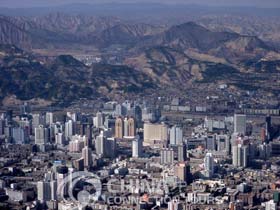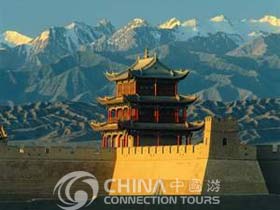 The city of Lanzhou lies at the geographical heart of China. Lanzhou, also known as Lan-chou or Lanchow, the capital of Gansu province, is a major transportation and industrial center and was an important stop on the Silk Road that linked China's ancient capital Xi'an with Central Asia and the Roman Empire. Lanzhou lies in the eastern part of Gansu Province along the Yellow River. On the map, the long, narrow province that carried Marco Polo to the eastern Middle Kingdom bears a slight resemblance to Italy. The foot of Gansu's 'boot' sits squarely between Qinghai and Shaanxi provinces, while its long, crooked leg reaches all the way to Xinjiang Province.
The city of Lanzhou lies at the geographical heart of China. Lanzhou, also known as Lan-chou or Lanchow, the capital of Gansu province, is a major transportation and industrial center and was an important stop on the Silk Road that linked China's ancient capital Xi'an with Central Asia and the Roman Empire. Lanzhou lies in the eastern part of Gansu Province along the Yellow River. On the map, the long, narrow province that carried Marco Polo to the eastern Middle Kingdom bears a slight resemblance to Italy. The foot of Gansu's 'boot' sits squarely between Qinghai and Shaanxi provinces, while its long, crooked leg reaches all the way to Xinjiang Province.
Lanzhou was once called the 'Gold City', due to the precious metal that was found there. It was this discovery, along with the fact that the city was a significant fortress (for around 1,400 years) on the Hexi Corridor, an eastern and crucial stretch of the Silk Road that led to a long period of great prosperity in the city. In recent years the city has grown enormously, so that it now snakes along the southern bank of the river for 30 km. Lanzhou's present-day industries include oil refining, chemicals, machinery, and wool textiles.
Geographical Features
Lanzhou is located between the Gaolan and the White Pagoda mountains. Branches of the Yellow River divide the city into several parts, giving Lanzhou a unique layout. The Yellow River flows through the city proper. It has one of the largest oil refineries in the country; a gas-diffusion plant for processing plutonium; is the center of China's atomic energy industry, and is one of China's leading petrochemical and nuclear power centers. Coal is mined nearby, and petroleum is shipped here by pipeline from Yumen.
Lanzhou today spreads many miles along a thin valley, sandwiched in by hills and the Yellow River. Nestled in a narrow valley overshadowed on either side by beautiful mountains and hills that are, today, no longer dead and brown but reveal the beginnings of new tree growth. This unusual geographical setting is responsible for Lanzhou's year round comfortable climate. It is this wonderful climate that has provided the city with favorable growing conditions for a large variety of summer melons, fruits and many other crops that include an abundance of roses and other flowers.
Located in west China, Lanzhou has a semi-arid climate, characterized by dryness and abundant sunlight. The annual average temperature is about 9.3 degrees C. Winter here is long and cold, but not freezing, with relatively little snow and rain. Spring is transient with sharp temperature swings. Summer is short and hot, but not sweltering. Autumn temperatures drop rapidly from their peak in July. The best time to go is from April through November. The annual precipitation is 30-800 millimeters (mainly falling in May through September), and sandstorms come in April and May.
People
With a population of 2.91 million people including an urban population of 1.6 million, there are 38 nationalities dwelling in Lanzhou, including those of Han, Hui (Muslims), Tibetan, Uygur, Dongxiang, Mongolian, Bonan, Kazak, Tu, Salar and Manchurian minorities.
History
 Some 5000 years ago, there were already people living in the Lanzhou area. Situated on the upper reaches of the Yellow River, Lanzhou was important for thousands of years because of the Hexi Corridor, or 'Corridor West of the Yellow River,' in which early Chinese civilization began. About 3,000 years ago, in the Zhou Dynasty, agriculture began to take shape in the basins of the Jin and Wei Rivers that formed the corridor, marking the beginning of the great Yellow River Basin civilization. Starting in the Qin Dynasty, merchants and traders traveling from Xi'an to central Asia and then on to the Roman Empire, or the other way round, broke their long journey at Lanzhou. To protect this corridor and important communications center, the Great Wall was extended during the Han Dynasty as far as Yumen, in the far northwest of present-day Gansu Province.
Some 5000 years ago, there were already people living in the Lanzhou area. Situated on the upper reaches of the Yellow River, Lanzhou was important for thousands of years because of the Hexi Corridor, or 'Corridor West of the Yellow River,' in which early Chinese civilization began. About 3,000 years ago, in the Zhou Dynasty, agriculture began to take shape in the basins of the Jin and Wei Rivers that formed the corridor, marking the beginning of the great Yellow River Basin civilization. Starting in the Qin Dynasty, merchants and traders traveling from Xi'an to central Asia and then on to the Roman Empire, or the other way round, broke their long journey at Lanzhou. To protect this corridor and important communications center, the Great Wall was extended during the Han Dynasty as far as Yumen, in the far northwest of present-day Gansu Province.
The city was named Jincheng, meaning 'strong fort' at the time of the Western Han Dynasty. It gradually became an important commercial center during the period from the Han Dynasty to the Tang and Song Dynasties during the zenith of the Silk Road. Later, the city played a dominant role in the promotion of economic and cultural exchanges between China and western countries.
During the Sino-Japanese war, Lanzhou was used as the distribution center for ammunition and supplies shipped into China from the Soviet Union. It was severely punished by Japanese bombing because of it. The discovery of oil in the nearby desert gave Lanzhou a major role in China's petrochemical industry after the People's Republic of China was founded.

